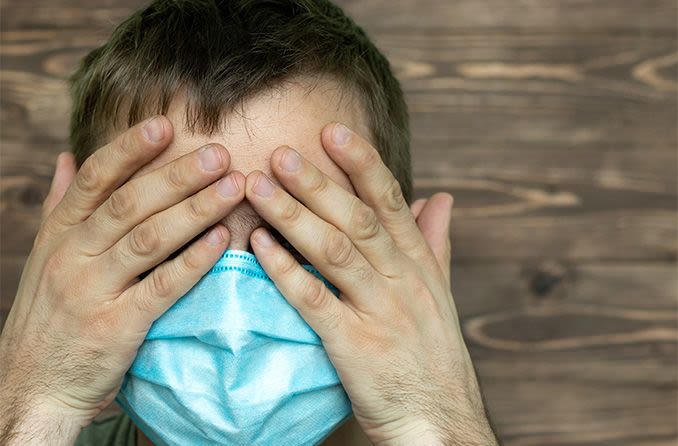Can coronavirus transmission happen through the eyes?

Much remains unknown about the novel coronavirus, including whether it truly can be transmitted through your eyes. But it’s likely that it can be.
The American Academy of Ophthalmology (AAO) says the virus is thought to spread mostly by person-to-person contact through respiratory droplets produced when an infected person coughs or sneezes. The World Health Organization (WHO) says it also can be transmitted through droplets of saliva or mucus from the nose.
Infected droplets (or infected mucus) can end up in an uninfected person’s mouth or nose and potentially travel to the lungs, according to the U.S. Centers for Disease Control and Prevention (CDC). The AAO notes that these droplets might enter through your eyes, too. Mucous membranes throughout the body are the most susceptible areas for virus transmission.
The novel coronavirus, which causes a respiratory disease called COVID-19, also might be spread if someone touches an object or surface (such as a doorknob or countertop) where the virus is present, and then touches their mouth, nose or eyes, according to the ophthalmology group.
But as the AAO and CDC emphasize, contracting the virus from an object or surface is thought to be responsible for only a minority of cases. Transmissions of this manner can be mitigated by proper hygiene and hand washing.
Possible coronavirus transmission through the eyes
When it comes to transmission through the eyes, the American Optometric Association (AOA) indicates the coronavirus might enter your body through the conjunctiva and then spread throughout your body through blood vessels within the conjunctiva.
The conjunctiva is the clear, thin membrane that covers part of the front of the eye as well as the inner part of the eyelids.
Some evidence suggests conjunctivitis, which is also known as pink eye, could be a symptom of COVID-19. However, this is said to be rare, with conjunctivitis developing in an estimated 1% to 3% of people with coronavirus.
SEE RELATED: Coronavirus linked to pink eye: How to protect your eyes
A connection between SARS and COVID-19
A small-scale study published in March 2020 in the journal JAMA Ophthalmology suggests the novel coronavirus might be transmitted through the eyes.
The study, based on data for 38 COVID-19 patients in China, says the new coronavirus might act like one of its cousins, the SARS virus. SARS (severe acute respiratory syndrome) is an illness caused by a different type of coronavirus.
Lack of proper eye protection was associated with an increased risk of SARS transmission, the study says. Therefore, the eyes are suspected as a route for spreading the SARS virus and, possibly, COVID-19.
Tears unlikely for coronavirus transmission
Another new study delivers some good news about transmission of the coronavirus via tears. For this study, published in March 2020 by the Journal Ophthalmology, researchers in Singapore collected tear samples from 17 COVID-19 patients. They detected no traces of the coronavirus in the patients’ tears, but the virus populated the patients’ noses and throats.
“Despite this reassuring news, it’s important for people to understand that guarding your eyes — as well as your hands and mouth — can slow the spread of respiratory viruses like the coronavirus,” says the ophthalmology group, which publishes the journal.
How you can help flatten the curve
So, what should you do to curb the spread of the current threat known as the novel coronavirus? Here are some tips:
Wash your hands frequently and thoroughly with soap and water. If you don’t have access to soap or water, clean your hands with an alcohol-based sanitizer.
Resist the urge to touch your eyes, nose and mouth.
Stay away from people who’ve been exposed to or contracted the coronavirus.
Cover your mouth and nose with a tissue when you cough or sneeze, or use the inside of your elbow. Throw tissues in the trash immediately after using them.
In addition, the American Academy of Ophthalmology says wearing glasses might block infected respiratory droplets from going into your eyes. However, they might not provide full protection, since droplets can still travel to your eyes through the exposed sides, tops and bottoms of the glasses. Wrap-around safety goggles might be a more effective alternative for those in direct contact with affected individuals.
Meanwhile, a growing number of health care professionals and disease specialists recommend wearing a non-medical face mask when outside your home to prevent unknowingly spreading the coronavirus. In many cases, people who have the virus don’t realize they could be infecting others because they aren’t exhibiting any symptoms.
Previously, experts said people shouldn’t wear face masks (even non-medical) unless they were sick and coughing, or unless they were going to be in close contact with someone who has the virus. Some health care professionals are sticking to that advice.
Medical masks are in increasingly short supply and should be reserved for health care workers, health officials say.
The importance of eye protection for medical professionals
Given the potential for transmission of the new coronavirus through our eyes, all front-line medical workers should protect their eyes, the American Optometric Association advises. This recommendation includes wearing a properly fitted N95 face mask along with glasses, goggles or a face shield that protect the eyes.
In addition, the CDC urges eye care professionals to put off routine eye care visits and elective procedures. Only emergency/urgent care patients are being seen by most eye care professionals until a time when safety guidelines around the transmission of COVID–19 are better understood.
SEE RELATED: Coronavirus: How eyes may play a role in its spread
Page published on Tuesday, 8 February 2022






